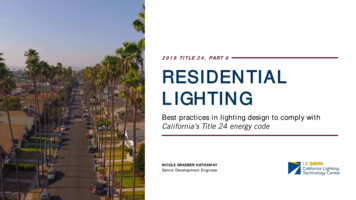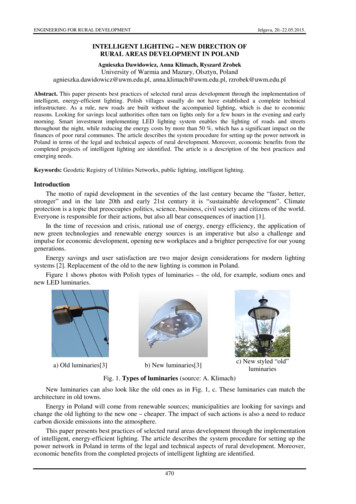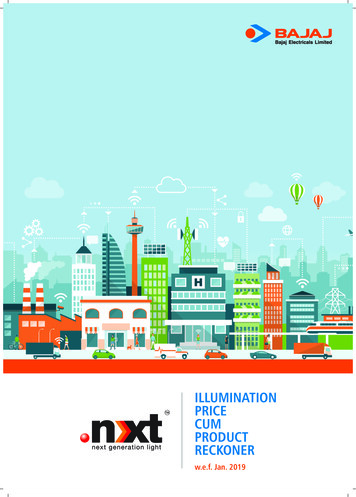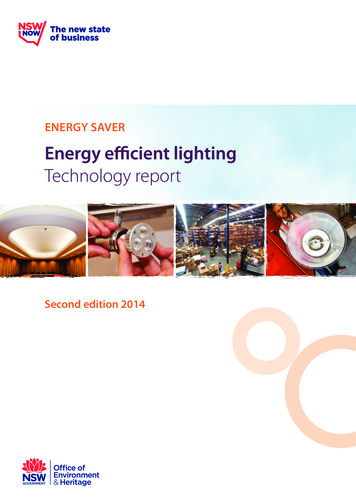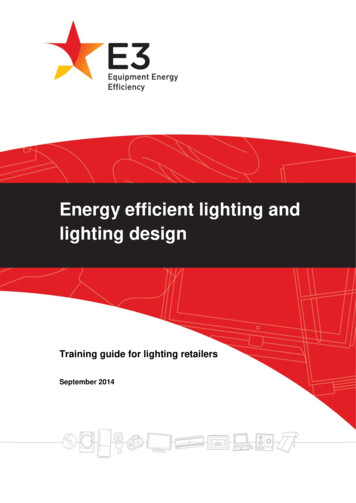
Transcription
Energy efficient lighting andlighting designTraining guide for lighting retailersSeptember 2014A joint initiative of Australian, State and Territoryand New Zealand Governments.
This work is licensed under the Creative Commons Attribution 3.0 Australia /au).The Department of Industry on behalf of the Equipment Energy Efficiency Program asserts theright to be recognised as author of the original material in the following manner: Commonwealth of Australia (Department of Industry) 2013.The material in this publication is provided for general information only, and on theunderstanding that the Australian Government is not providing professional advice. Before anyaction or decision is taken on the basis of this material the reader should obtain appropriateindependent professional advice.This document is available from the Energy Rating website (www.energyrating.gov.au).While reasonable efforts have been made to ensure that the contents of this publication arefactually correct, E3 does not accept responsibility for the accuracy or completeness of thecontent, and shall not be liable for any loss or damage that may be occasioned directly orindirectly through the use of, or reliance on, the contents of this publication.E3 Energy efficient lighting and design: training guide for retailersii
PrefaceLighting accounts for around 12% of electricity usage in households. The AustralianGovernment recognises that household lighting is an area where significant energy savings can bemade by replacing inefficient lights with more cost-effective and energy efficient alternatives.The phasing out of inefficient lighting was announced in 2007, and will deliver considerablesavings to the environment and the economy. Across the country, the switch to more efficientlighting is expected to save approximately 30 terawatt hours of electricity and 28 million tonnes ofgreenhouse gas emissions between 2008 and 2020. This is equivalent to permanentlydecommissioning a small coal-fired power station or taking more than 500,000 cars off the road.Further information on the phase-out is available from the Department of cy/Lighting/Pages/default.aspx).Energy efficiency savings in the home is achieved by a combination of choosing energy efficientlighting products, and efficient and effective design. Lighting retail stores are well positioned toassist customers to make lighting choices that result in more efficient energy use and good lightquality for their homes.This guide will help retailers and their customers achieve improved energy efficiencyoutcomes through the selection of more efficient lighting and understanding ofbetter lighting design.E3 Energy efficient lighting and design: training guide for retailersiii
ContentsPREFACE . IIICONTENTS . IV1.INTRODUCTION TO QUALITY LIGHTING . 11.1.Lighting to suit the lifestyle of the household . 11.2.General / ambient lighting . 21.3.Task / accent lighting . 32.THE CHARACTERISTICS OF LIGHT. 42.1.The amount (quantity) of light . 4Luminous flux (measured in lumens) . 4Efficacy (lumens/Watt). 4Luminous intensity (candela) . 4Illuminance (lux) . 4Luminance (candela/m²). 52.2.The colour (quality) of light . 5Colour temperature. 5Colour rendering index (CRI) . 83.ALL ABOUT LAMPS. 93.1.Lamp Technologies . 9Tungsten filament incandescent . 9Halogen . 9Fluorescent (Linear, Circular). 10Compact fluorescent lamp (CFL) . 10Cold cathode fluorescent lamp (CCFL) . 11Light emitting diode (LED). 11Metal halide . 12Induction . 123.2.Comparison chart . 133.3.Conversion chart . 143.4.Lamp lifespan . 143.5.Lamp life calculator . 153.6.Lamp usage cost comparison. 163.7.Lamp labelling. 174.AUXILIARY EQUIPMENT . 184.1.Ballasts . 184.2.Starters . 184.3.Transformers/voltage converters . 194.4.LED drivers . 194.5.Dimmers. 205.USING LIGHT EFFICIENTLY. 215.1.Controls . 215.2.Multiple switch circuits . 215.3.Timers . 215.4.Motion sensors . 22Passive infrared sensors (PIR) . 22Ultrasonic (US) sensors . 22Microwave (MW) sensors . 225.5.Building management system (BMS) . 23E3 Energy efficient lighting and design: training guide for retailersiv
6.GOOD LIGHTING DESIGN . 246.1.Lamp applications . 246.2.Omnidirectional . 256.3.Hemispherical . 266.4.Directional. 266.5.Lamp technologies and their applications .276.6.Lighting design by room .276.6.1. Kitchen . 296.6.2.Dining/living . 296.6.3.Bedrooms/studies . 296.6.4.Bathroom . 306.6.5.Entrance/security. 306.6.6.Utility areas . 317.BASIC LIGHTING DESIGN CALCULATIONS . 327.1.Recommended levels . 327.2.Basic luminous flux requirement. 327.2.1. Ambient lighting. 32‘Rule of Thumb’ Lumen Method (less accurate, but a good guide) . 337.2.2.Specific task lighting . 33Inverse square law equation . 34Off-axis inverse square law equation . 347.3.Beam angle . 35Beam angle definition . 357.4.Calculating energy use and costs .378.LIGHTING REGULATIONS. 388.1.Building Code of Australia requirements linked to lighting . 388.2.Australian Standard on electrical safety . 399.LIGHTING FOR PERSONS WITH VISUAL IMPAIRMENT . 409.1.Restricted iris expansion . 409.2.Cloudiness within the lens or floaters within the vitreous gel . 419.3.Damage to parts of the retina . 419.4.Macular degeneration. 429.5.Tunnel vision . 429.6.Lighting design for the visually impaired . 4310.LIGHTING AND HEALTH . 4410.1.Minimising UV light exposure. 44Enclosed lamp fixtures. 44Indirect lighting . 45Distance . 45Double envelope CFLs . 4510.2. Flicker . 45Photosensitive epilepsy . 46Ménièr’s disease. 46Migraines . 4611.GLOSSARY OF BASIC LIGHTING TERMINOLOGY . 47Ballast .47Colour rendering.47Colour temperature.47Control gear .47Diffuser .47Discharge lamp .47Efficacy (luminous efficacy) .47Illuminance.47Intensity (Candela) .47Kelvin.47E3 Energy efficient lighting and design: training guide for retailersv
Light output ratio (LOR) .47Luminaire .47Lumen.47Luminance (Candela/m2) . 48Lux . 48Rated average lamp life. 48Re-strike . 48Start-up. 48Universal operating position. 48E3 Energy efficient lighting and design: training guide for retailersvi
1.Introduction to quality lightingThe need to be energy efficient has never been more topical than it is today – with awareness of theneed to reduce greenhouse gas emissions, financial pressures and incentives, and regulatoryrequirements all encouraging a move towards greater energy efficiency in the household.In the home there are many opportunities to apply energy efficiency strategies and lighting is oneof these. Energy efficiency in lighting is a key part of modern home design, and is a feature ofplanning and construction regulations for new homes and some renovations. In addition, there isan ever-expanding range and variety of light sources that can be used in the home.This training guide will provide information about the different types and uses of energy efficientlighting, including how to achieve effective and quality lighting design outcomes.1.1. Lighting to suit the lifestyle of the householdLighting should be planned to complement the lifestyle of the household. Consider the activitiesthat occur in each room, the atmosphere that the householder wants to create, and the decorativeelements that are to be emphasised.Advanced lighting design combines multiple daylighting and electrical lighting strategies tooptimise the distribution of light inside a building. It considers the energy impacts of the wholebuilding, minimising the building’s overall energy usage and integrating the design of the daylightapertures with the electric lighting design and controls. Effective lighting design means puttinglight where it is wanted and needed and eliminating light where it is not wanted or needed.Consideration should be particularly given to areas that serve more than one purpose and requiremore than one style of lighting (e.g. relaxed entertaining, media viewing, reading/writing, generalactivity). Lights may need to be on separate switches, and/or dimmers used to create the desiredlighting effect.Room surfaces and furnishings can greatly influence a room’s appearance, for example: dark colours absorb light often leading to over-illumination to compensate; and light colours reflect light and can be considered as an additional source of illumination.There is no ‘best’ lamp – each has advantages and disadvantages. By virtue of the way that light isgenerated by different lamp technologies, one type of lamp may be better suited than another forproducing a particular light distribution. Good design utilises the best product for each application.For example, some compact fluorescent lamps (CFLs) may take a few seconds to start and ‘warmup’ to full brightness, therefore they may be less suitable in areas where lights are required toswitch on and off quickly or are only needed for a few seconds (e.g. the kitchen pantry). Eventhough CFLs are more energy efficient, light emitting diode (LED) lamps or halogen lamps may bea better choice in these circumstances.Most rooms require two types of lighting: general/ambient lighting and task/accent lighting.Different lamps and light fittings should be used for each purpose.E3 Energy efficient lighting and design: training guide for retailers1
1.2.General / ambient lightingAmbient lighting provides overall, general lighting that radiates at a comfortablebrightness level.Having a well-placed source of ambient light in all rooms is fundamental to a good lighting plan.The size, shape and purpose of the room will determine how extensive the ambient lighting schemeneeds to be. In general terms, smaller rooms having a rectangular shape can be adequatelyilluminated from a central location. Larger rooms or rooms which have non-rectangular shapessuch as an ‘L’ shape will need more than one source of light to ensure even and adequate coverage.Ambient lighting can be applied in three ways: direct, indirect or direct/indirect combination.Direct lighting means that the light from the light fitting is delivered directly to the main objects inthe room. This is an efficient form of lighting as the light reaches the target areas directly; it is notmodified or absorbed in anyway. Direct illumination is typified by a ceiling mounted light bulb withthe majority of light sent downward into the room.Indirect lighting makes use of room surfaces to ‘bounce’ or reflect light in the room. This isusually the ceiling, but occasionally walls and other surfaces are also used. The light source iscommonly mounted in a suspended luminaire from the ceiling, or is wall mounted so that themajority of light is distributed in an upward direction. This modifies the light in two ways:1. Most surfaces used for this purpose are diffusing surfaces that scatter the reflected light inall directions, making the reflected light ‘softer’ so that shadow lines are far less noticeable,if visible at all.2. The reflecting surface is far larger in size than the primary light source itself, so thereflected light is not only diffuse but is also less bright than the direct illumination source.The combination of diffuse light radiating from a much larger area greatly reduces harsh shadowlines and provides a smooth uniform illumination. However, some light is absorbed and scatteredwith each reflection so indirect lighting is generally less efficient than direct. Wall sconce lightingand the uplight floor lamp are both good examples of indirect lighting used in homes.Direct/indirect lighting is simply a combination of both direct and indirect lighting. A typicalexample is a floor lamp with a barrel style lampshade; this throws a portion of light upward to bereflected from the ceiling, while the rest of the light is directed downward.Lighting in most household spaces is neither purely direct nor indirect, so rather than trying toclassify the type of lighting too rigidly, it is simply important to consider what part of the lighting ismost obvious or dominant – direct or indirect.E3 Energy efficient lighting and design: training guide for retailers2
1.3.Task / accent lightingTask lighting, such as a desk lamp, is used to illuminate specific tasks such as reading, sewing,cooking, homework, games or hobbies.Accent lighting adds drama to a room by creating visual interest. This might mean emphasisingpaintings, house-plants, collectables, or to highlight the texture of a wall, drapery or outdoorlandscaping.Regardless of the purpose, the fundamental considerations for task and accent lighting are thesame:1. Will I be able to see the task or object of regard clearly?2. Will the lighting directly interfere with anyone else?3. Does the lighting generate unintentional and distracting shadows or reflected images?E3 Energy efficient lighting and design: training guide for retailers3
2.The characteristics of lightWhen designing a lighting scheme and choosing appropriate light sources for households, there aretwo key characteristics that need to be understood:1. the amount (quantity) of light produced; and2. the colour (quality) of light produced.2.1.The amount (quantity) of lightThe amount of light produced is measured in photometric quantities. There are five measures ofphotometric quantities.Luminous flux (measured in lumens)The lumen is a unit of luminous flux, a measure of the total amount of visible light emitted by alamp. The higher the lumens, the more visible light emitted by a lamp.Efficacy (lumens/Watt)Efficacy is a word specifically referring to how efficiently the light source converts electrical energyinto visible light. This word was chosen to separate the process from other forms of efficiency, suchas the efficiency of the light fitting reflector system or efficiency of the control gear. It is importantto understand that efficacy refers to the power consumed by the light source and the visible lightthe lamp produces from this consumption. The units of efficacy are lumens/Watt, i.e. how muchlight is generated per unit of power consumed. By comparing two lamps with a similar luminousflux, the comparative energy efficiency of the products can be evaluated. The higher the efficacy,the more efficient the product.Luminous intensity (candela)Intensity is the amount of light radiated in a given direction, measured as Candela (cd). Thesuperseded non-reflector tungsten filament incandescent lamp or its CFL equivalent radiates lightequally in all directions, much like the sun. Thus, from any direction the lamp appears to have thesame ‘brightness’ or intensity. If we now consider a reflector lamp such as the low voltage MR16downlight, we can see that it radiates in a specific direction. The reflector gathers some of the lightfrom non-useful directions and projects it in directions that are useful. Intensity becomes a moreuseful characteristic when we consider directed light such as that from reflector lamps. The higherthe candela, the higher the intensity of the light.Illuminance (lux)As luminous flux travels outward from a source, it ultimately interacts with surfaces where it willreflect, transmit, and/or be absorbed. Surface illuminance is the portion of emitted luminous fluxthat falls on a surface area. This yields lumens per square metre, or lux (the most common namefor the unit of illumination).It should be noted that illuminance is never directly visible as a quantity of light. The viewer seesonly the reflected light from the surface: this is the luminance of a physical surface.E3 Energy efficient lighting and design: training guide for retailers4
Luminance (candela/m²)Luminance indicates how bright an object will appear and is measured as candela (intensity) permetre square (m2). Light emanati
lighting, including how to achieve effective and quality lighting design outcomes. 1.1.Lighting to suit the lifestyle of the household Lighting should be planned to complement the lifestyle of the household. Consider the activities that occur in each room, the atmosphere



